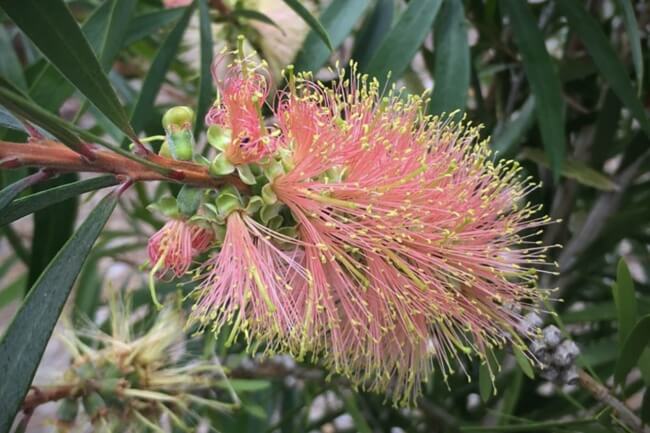Callistemon ‘Pink Champagne’ is an evergreen bottlebrush that is hardy, easy to grow and maintain. It tolerates most soil conditions and produces spectacular displays of pink bottlebrush flowers.
The plant typically flowers in spring and autumn. Not only are the soft pink flowers beautiful but they will attract a plethora of birds and insects to your garden.
A robust, native Australian shrub that works equally well as a feature plant, flowering screen, or hedge. This drought-tolerant plant is also a good option for coastal gardens.
This gardening guide covers everything you need to know about successfully growing Callistemon ‘Pink Champagne’.
More...
Botanical name: | Callistemon citrinus ‘Pink Champagne’ |
|---|---|
Botanical family: | Myrtaceae |
Wha is Callistemon ‘Pink Champagne’?

Callistemon is a genus of shrubs in the Myrtaceae or Myrtle family, commonly referred to as bottlebrushes. These attractive shrubs or shrubs have cylindrical brush-like flowers which come in a variety of shades including cream, yellow, pink or red.
Callistemon are very adaptable plants and are appropriate for all Australian climates except the very coldest areas. One of the prettiest bottlebrush trees for Australian gardens is the cultivar Callistemon citrinus ‘Pink Champagne’.
This Australian native plant is also commonly known as Pink Champagne Bottlebrush, due to the colour of the foliage. Callistemon ‘Pink Champagne’ is a quick-growing, evergreen upright shrub which grows to a height of 2-3m and can spread up to 1-2m wide at maturity.
The stunning perennial shrub has narrow grey-green coloured foliage and produces beautiful soft pink flowers for an extended period of the year. Callistemon ‘Pink Champagne’ is a very adaptable plant to both wet and dry conditions.
It also has good tolerance to salty soils making it suitable for coastal gardens. This bottlebrush will tolerate periods of hot sun and dryness once established.
When Does Callistemon ‘Pink Champagne’ Flower?
Callistemon ‘Pink Champagne’ flowers in late winter, spring, and autumn depending on the climate. The flowering is normally less prolific in autumn than spring but still brings some nice colour to the garden.
This Callistemon cultivar produces attractive soft pale pink flowers which contrast beautifully with the grey-green foliage. These flowers fade to white as they age so the plant often displays various shades of pink across the bush.
Remove the flower brushes as they fade, which should encourage new growth and flowers. Nectar-seeking birds love flowering Australian plants like Callistemon ‘Pink Champagne’. It will also attract a multitude of insects for other birds to feed on.
Growing Callistemon ‘Pink Champagne’
Ideal Soil and Planting Location
Pink Champagne bottlebrushes can grow well in most soil types. This cultivar can even be grown successfully in clay soils. As a native, the plant is well adapted to low nutrient Australian soils so there is no need to add additional material.
Callistemon ‘Pink Champagne’ should be grown in a sunny spot of the garden. Given the plant’s adaptability, it can be grown in a wide variety of soils. It will even do okay in heavy clay soil and survive temporary waterlogging.
This is a tough, hardy plant. It can be grown in windy exposed sites and can be used as a windbreak. This bottlebrush is attractive even when not flowering. Callistemon ‘Pink Champagne’ is a great option for the garden if you are looking for a flowering hedge or screening plant.
This beautiful bottlebrush is the perfect companion plant with other Australian trees and shrubs.
Caring for Pink Champagne Bottlebrush

Callistemon ‘Pink Champagne’ is a tough, hardy Australian native shrub. It will be a low maintenance addition to your garden and will look after itself. Until the plant becomes established in your garden, you will need to water the bottlebrush regularly. After about 3 months you can dial back watering in accordance with weather conditions.
Pink Champagne Callistemon are drought tolerant plants and have low water requirements. Water the tea tree during extended hot, dry periods but otherwise rainfall should be sufficient to keep this Callistemon plant happy.
These native plants can grow quite happily in low nutrient soil so don’t need additional fertiliser to thrive. To help flowering you can add some all-purpose Australian native plant fertiliser, but this isn’t strictly necessary.
Callistemon ‘Pink Champagne’ should be pruned to shape after flowering. Not only does this keep the plant tidy and shaped but the bottlebrush may even produce a repeat performance of flowers. The bottlebrush will also tolerate more severe pruning if required or if you are trying to form a hedge.
Callistemon citrinus ‘Pink Champagne’ are problem-free and are not typically impacted by pests and diseases.
You're Now Ready to Grow Callistemon ‘Pink Champagne’
This versatile and tough Callistemon is a great choice for Australian gardeners. Whether it’s used as a feature plant, windbreak, flowering screen or hedge you can’t go wrong with this pretty plant.
The upright evergreen shrub will thrive with lots of sun. It is drought tolerant and will do well in most soil conditions. It also grows well in quite wet conditions. This native plant will produce a glorious display of pink bottlebrush flowers in spring and autumn adding colour and texture to your garden.
Callistemon ‘Pink Champagne’ is easy to maintain and typically only requires a trim after flowering. Please don’t hesitate to get in touch if there is anything more you would like to know about growing Callistemon ‘Pink Champagne’.
Published on August 23, 2023 by Gary Clarke
Last Updated on January 26, 2024




